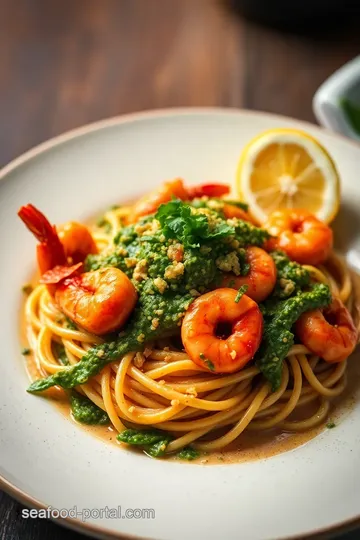Spicy Prawn and Noodle Pesto Delight

Delight your taste buds with this vibrant and flavorful dish of egg noodles tossed with juicy king prawns, fresh vegetables, and a zesty pistachio pesto. Perfect for a quick and healthy meal!
Cook time:
Total time:
Yield:2 servings
Ingredients
- 140 g (2 blocks) egg noodles
- 300 g king prawns
- 6 baby corns
- 100 g carrot shavings (about 1 medium carrot)
- 2 limes
- Fresh coriander
- Basil
- 50 g shelled pistachios
- 10 ml white rice vinegar
- 30 ml water
- 40 ml rapeseed oil
Instructions
- To make the pesto, blend together the pistachios, rapeseed oil, white rice vinegar, chopped basil, fresh coriander, and the juice and zest of 2 limes. For a spicier kick, you can add chili. To achieve the right consistency, add about 30 ml of water to help blend.
- In a separate pot, cook the egg noodles in salted boiling water according to package instructions.
- In another pot with salted boiling water, blanch the baby corn for about 2 minutes. Cool them down and cut at an angle.
- While the noodles and corn are cooking, heat a frying pan with a little cooking oil. Once the pan is smoking hot, add the king prawns (make sure they are dry for better color and flavor) and season with salt. Sear the prawns until they are cooked through.
- Add the carrot shavings and blanched baby corn to the pan, then toss everything in the prepared pesto. Finally, mix in the cooked noodles until well coated.
- Garnish with roughly chopped coriander and drizzle with chili oil if desired.
Nutritional Information
Nutrition details per serving are not available at this time.

Enhancing Your Recipe s Online Visibility
In today s digital age, it s crucial to ensure your culinary creations are easily discoverable online. One of the first steps in improving search engine visibility is to incorporate relevant keywords throughout your recipe. For our "Spicy Prawn and Noodle Pesto Delight," using keywords like "prawns," "noodles," and "healthy meals" should be a priority. Ensure these keywords appear in the title, headings, and throughout the content to help search engines understand what your recipe is about. Additionally, make sure to add alt text to images of your dish, using descriptive phrases that include your target keywords.
Optimizing Your Recipe for Featured Snippets
Featured snippets are a great way to gain visibility in search results. To optimize your recipe for these snippets, structure your content with clear headings and bullet points. For example, use
for key steps in your instructions and for your ingredients list. This structured format not only helps search engines parse your content more easily but also makes it user-friendly. Highlighting important information, such as cooking times or serving sizes, can further entice users to click through to your recipe.
Utilizing Social Media for Recipe Promotion
Social media platforms are powerful tools for promoting your recipes. Share your "Spicy Prawn and Noodle Pesto Delight" on platforms like Instagram, Pinterest, and Facebook. Use engaging visuals and hashtags related to your dish, such as #PrawnRecipes and #HealthyEating. Engaging with your audience through comments and sharing user-generated content can also enhance your visibility. Encourage followers to share their own versions of your dish, creating a community around your recipe that can drive more traffic to your website.
The Importance of Mobile Optimization
With a significant number of users accessing recipes on their mobile devices, ensuring your website is mobile-friendly is essential. A responsive design that adapts to different screen sizes can improve user experience and decrease bounce rates. Fast loading times are also critical—optimize images and scripts to ensure your recipe loads quickly. This not only keeps users on your page longer but also signals to search engines that your site provides a good user experience, potentially improving your rankings.
Engaging Your Audience with Quality Content
Creating quality content that resonates with your audience is vital for building a loyal following. Consider writing a blog post that shares personal anecdotes related to your "Spicy Prawn and Noodle Pesto Delight," such as its origin or variations you enjoy. This narrative can enhance the emotional connection with readers and encourage them to share your recipe. Additionally, including comprehensive tips on how to enhance the dish or variations for dietary restrictions can provide added value, making visitors more likely to return.
FAQs About Recipe Optimization
What are keywords and why are they important for recipes?
Keywords are specific words or phrases that users enter into search engines. They are critical for recipe visibility because they help search engines match your content with user queries. Including relevant keywords in your recipe title and description can significantly improve your chances of appearing in search results.
How can I drive traffic to my recipe blog?
To drive traffic, consider utilizing social media, collaborating with food influencers, and engaging with food communities online. Regularly updating your content and using SEO best practices can also attract more visitors to your blog.
Is it necessary to have a blog to share recipes?
While having a blog can be beneficial for sharing recipes in detail, you can also use platforms like Instagram or Pinterest to share quick recipe cards or videos. However, a blog allows for deeper engagement with your audience and better SEO optimization.
What is the best way to format a recipe for online viewing?
The best way to format a recipe for online viewing is to use clear headings for sections like ingredients and instructions, incorporate bullet points for easy reading, and include images. Ensure the recipe is mobile-friendly to cater to users on different devices.


















